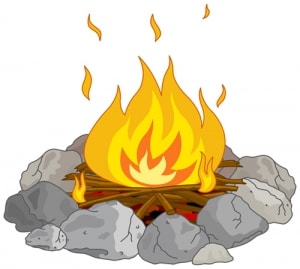History of the Fireplace

Ancient fire pits, many hundreds of thousands of years ago represented the first creation, which eventually would become what we know as a fireplace.
In the early years for fires inside a dwelling, a hearth was created for fires and louvers made to allow smoke to escape. These two developments formed the basis of how fires were to evolve over many hundreds of thousands of years to come.
Starting in the Medieval Period, houses of varying levels of splendour were constructed with chimneys and fireplaces. Fireplaces were built out of stone or brick, and a typical fireplace setup involved:
The Chimney or Flue
The long stone, or brick pipe or vent, which channeled the smoke up and out of the building.
Chimneys were invented around the 11th century and made it possible to have numerous fires in different rooms, without the problem of smoke and fumes, which before chimneys posed a real problem.
The Smoke-box
The chamber at the bottom of the chimney-pipe, which acted as a buffer against downdrafts.
The Fire-Box/Fireplace
This is directly under the smoke-box, and it’s where the fire itself would be located.
The Hearth
The stone or brick platform on which the firebox and chimney is built. Sometimes extends outside of the fire-box into the room, to provide extra protection against rolling logs.
In the 18th century Benjamin Franklin developed a convection chamber for the fireplace. This invention improved the efficiency of stoves and fireplaces. The initial design for the modern fireplace as we know, comes from Count Rumford after he designed a fire with a tall, shallow firebox, which was better at drawing up smoke out of the building.
In the past, fireplaces were designed for keeping warm and cooking food (starting from a cave onwards). As time progressed, they became more of an attractive centre point in a room, and of course for providing warmth.
.
Fireplaces by Periods:
500AD – Medieval England
.
English peasants lived in small huts with a central fire pit for cooking and warmth with smoke exiting though a hole in the roof
1066 – New fireplaces
Fire pits were replaced with fireplaces and moved to the outside wall, which made it possible to put a fire in each room.
1700s – Coal
Timber became scarce during this period and so coal became more commonly used.
1741 – Franklyn Stove
A Franklyn stove was a free standing cast iron stove, normally located in the centre of a room. It used an “inverted siphon” which allowed fumes to be drawn out of the chimney. It was also able to radiate twice the heat using a quarter of the fuel.
1796 – Count Rumsford
Count Rumsford invented the smaller, shallow fireplaces, which set the design, which we know nowadays.
1900s – Central Heating
With the introduction of central heating, fireplaces were relied upon less for warmth. They became more of a functioning focal point for decoration and warmth.
Fireplaces – both gas, electric and wood burners continue to become safer, more efficient ways to help heat a home. Although they are nowadays partly a design focal point, they still are an excellent way to heat a room, and hopefully will continue to do so, for many more generations.








